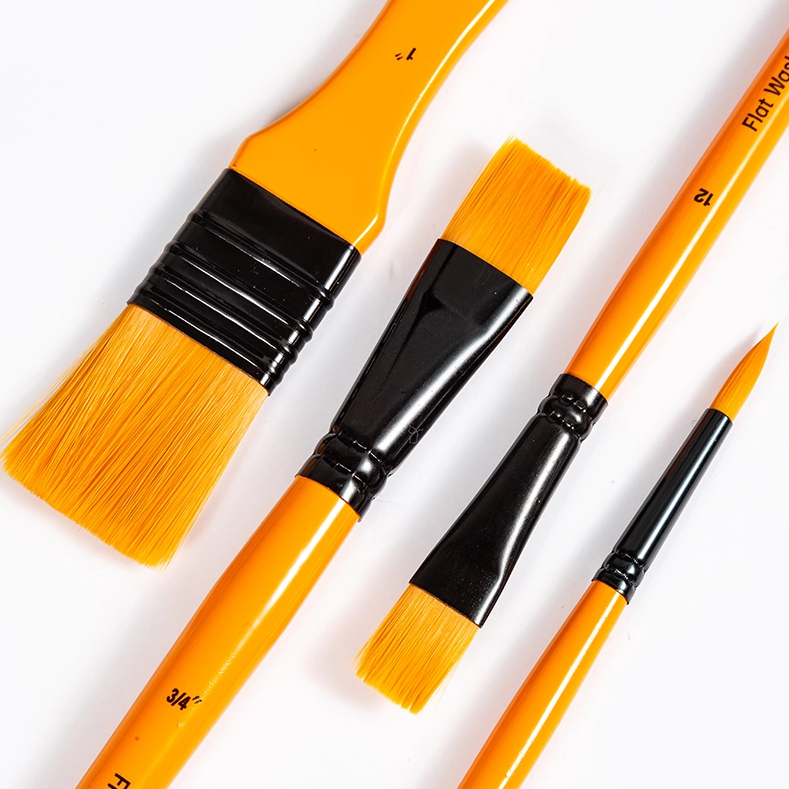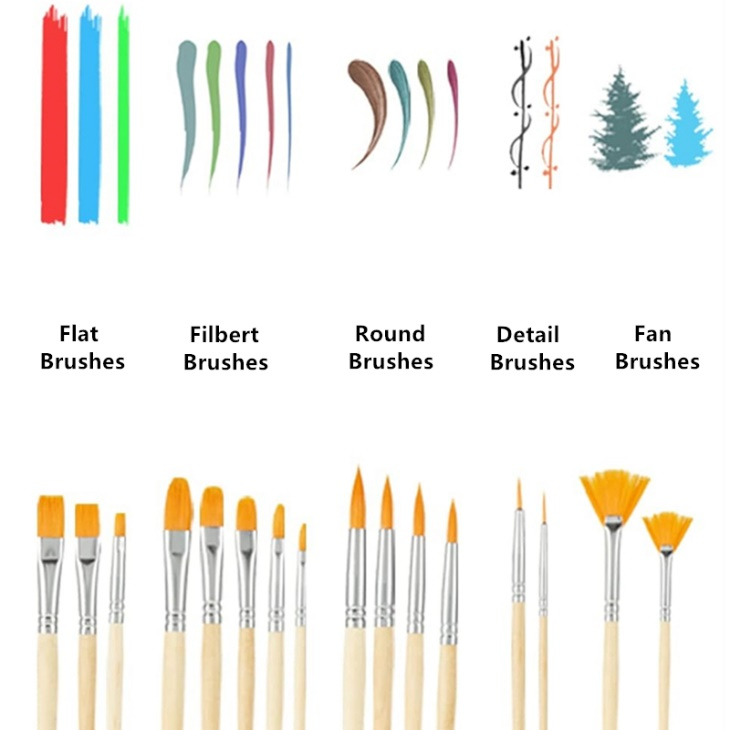Views: 0 Author: Site Editor Publish Time: 2025-06-14 Origin: Site








Paint brushes are essential tools for any artist, whether you're a beginner or a seasoned professional. The quality and type of brush you choose can have a significant impact on the outcome of your artwork. From fine details to broad strokes, the right brush makes all the difference in achieving your artistic vision. However, with so many options available, it can be overwhelming to choose the right one. This article will explore the different types of paint brushes, the materials they are made from, and the best options for various painting mediums.
Each type of paint brush is designed for a specific purpose and technique. Understanding the different brush shapes can help you choose the right tool for your project:
Flat Brushes: Flat brushes have square ends and are perfect for creating bold, sweeping strokes, as well as filling in large areas. They can also create sharp edges and straight lines, making them versatile for both background work and detailed lines.

Round Brushes: These brushes have a pointed tip, which allows for fine details, intricate lines, and precise work. Round brushes are great for creating thin, controlled strokes and are often used for detail work in all painting mediums.
Filbert Brushes: Filbert brushes combine the shape of flat and round brushes, with an oval-shaped tip. These are excellent for blending and creating soft, rounded strokes, making them ideal for portraiture and other areas where soft edges are required.
Angle Brushes: These brushes have slanted bristles, which are great for precise and controlled lines. Angle brushes are perfect for painting edges and creating sharp, clean lines, often used for trimming or in detailed designs.
Fan Brushes: Fan brushes have a spread-out, fanned shape, making them perfect for creating texture. They are often used for blending, dry brushing, and adding special effects, like foliage in landscape paintings.
The type of brush you choose depends on the desired effect:
For detailed work: Round brushes, especially in small sizes, are perfect for fine lines, details, and intricate designs.
For broad strokes: Flat brushes are ideal for creating smooth, bold strokes when covering large areas quickly.
For specific techniques: Filbert brushes excel in blending, while angle brushes are great for sharp, clean edges. Fan brushes can create textures such as fur, grass, and leaves.
The bristles of a paint brush play a crucial role in its performance. Brushes can be made with either natural or synthetic bristles, and the choice depends on the type of paint and the desired effect:
Natural Bristles: These are made from animal hair, such as sable, hog, or goat hair. Natural bristles are ideal for oil and watercolor paints as they hold more paint and provide a smooth, natural finish. Sable brushes, in particular, are known for their softness and ability to hold a large amount of paint, making them perfect for fine details.
Synthetic Bristles: Synthetic brushes are made from man-made fibers like nylon or polyester. These brushes are generally more affordable and offer greater durability, especially when working with acrylics. They are also more resistant to wear and tear compared to natural bristles and can be easily cleaned. Synthetic bristles are ideal for water-based paints, such as acrylics and watercolors.
Sable Brushes: Sable brushes are made from the soft fur of weasels, minks, or sables. These brushes are known for their excellent point retention and their ability to hold a large volume of paint, making them perfect for delicate work like watercolors. Sable brushes are expensive but are favored by professionals for their precision and fine performance.
Hog Bristle Brushes: Hog bristle brushes are made from the coarse hair of hogs and are commonly used for oil painting. They are strong, stiff, and durable, making them ideal for applying thick layers of paint. Hog bristle brushes are particularly effective for impasto techniques and heavy-bodied paints, giving artists control over texture and consistency.
Synthetic Brushes: Synthetic brushes are designed to mimic the performance of natural hair. They are particularly suitable for acrylic and watercolor paints. Synthetic bristles are stiffer than natural bristles, making them ideal for handling the fast-drying nature of acrylics. They are also highly resistant to damage and can last for a long time if properly cared for.
Stiff Bristle Brushes: For oil painting, hog bristle brushes are the best choice due to their stiffness, which allows artists to apply thick layers of paint. These brushes are perfect for impasto techniques and creating texture in oil paintings.
Brush Shapes and Sizes for Oils: Flat brushes are great for creating broad strokes, while round and filbert brushes are ideal for fine details and blending. Larger brushes work well for covering large areas, while smaller ones are used for intricate details.
Firm Brushes for Acrylics: Acrylic paint dries quickly, so it requires firm brushes that can handle the fast-drying consistency. Synthetic brushes are often recommended because they hold up well to acrylics’ thick, heavy consistency.
Blending and Detail Brushes: Acrylics require both large brushes for broad strokes and smaller brushes for fine details. Flat brushes and filberts work well for blending and glazing techniques.
Soft Brushes for Watercolors: Watercolor paint is often used with soft, natural bristle brushes, such as sable or squirrel hair brushes. These brushes hold a large amount of water and paint, which is essential for achieving smooth, delicate washes.
Choosing the Right Size: Round brushes are commonly used for watercolor painting, as they can hold both water and pigment efficiently. For finer details, smaller round brushes are used, while larger rounds are great for washes and broad strokes.

Bristle Tips and Strength: The best brushes have bristles that are fine, strong, and flexible. Good quality brushes retain their shape and provide consistent strokes over time. Premium brushes often feature hand-tied bristles that stay in place and deliver superior performance.
Shape Retention: High-quality brushes retain their shape and do not lose their bristles easily. Brushes that hold their shape better give artists more control over their strokes and provide smoother, more uniform coverage.
Comfortable Handles: A high-quality brush will have a comfortable, well-balanced handle. Long handles are ideal for artists who work at an easel, while shorter handles are better for close-up, detailed work on a table.
Handle Material: Handles are usually made from wood or durable plastic. The wood should be smooth, ergonomic, and lightweight, ensuring comfort during long painting sessions.
Brush Durability: High-quality brushes can withstand repeated use and maintain their performance over time. Brushes made from durable materials, such as synthetic fibers or premium animal hair, last longer and retain their shape after cleaning.
Care and Maintenance Tips: Proper cleaning and storage of brushes are essential to prolong their lifespan. Clean brushes immediately after use, using the appropriate cleaner for the paint medium (e.g., water for acrylics, solvent for oils).
Winsor & Newton: Known for their excellent craftsmanship and high-quality hog bristle brushes, which are perfect for oil paints.
Princeton and Da Vinci: Popular for their fine, durable brushes made specifically for oil painting, offering precise control over thick and thin applications.
Silver Brush Limited: Offers a wide range of synthetic brushes ideal for acrylics, providing great durability and performance.
Creative Mark: A trusted brand for affordable yet high-quality acrylic paint brushes, recommended by many professional artists.
Escoda and Kolinsky Sable: These brands are renowned for their exceptional sable brushes, perfect for achieving the finest details and smooth washes in watercolor painting.
Raphaël: Famous for their excellent quality round brushes, ideal for watercolor applications requiring precision and control.
Cleaning Tips: To clean brushes, use warm water and mild soap for water-based paints, or an appropriate solvent for oil paints. Always wash brushes immediately after use to prevent paint from hardening in the bristles.
Storing Brushes: Store brushes upright in a brush holder or a container, ensuring that the bristles don’t get damaged. Never leave brushes lying flat as this can distort their shape.
Conditioning Your Brushes: To keep bristles soft and in top condition, occasionally use brush conditioner or mild soap.
Avoiding Wear and Tear: Never leave brushes in water or solvents for extended periods, as this can damage the bristles and cause the brush to lose its shape.
Selecting the best paint brush is an essential step in achieving your desired artistic results. Whether you’re working with oils, acrylics, or watercolors, using the right brush for your medium will enhance your ability to create detailed, professional-level artwork. Invest in high-quality brushes, take good care of them, and choose the right type based on your specific needs to elevate your artistic journey.
A: For beginners, a basic set of synthetic brushes is ideal as they are affordable and versatile for most painting mediums.
A: While it’s possible, different paints (oil, acrylic, watercolor) work best with brushes specifically designed for them due to their differing consistencies and drying times.
A: The right brush size depends on the detail needed. Smaller brushes are better for fine details, while larger brushes are best for broad strokes.
A: Clean brushes thoroughly after each use, store them properly, and avoid overworking them to maintain their shape and longevity.